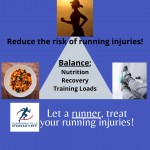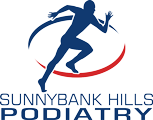Reducing The Risk Of Running Related Injuries
At Sunnybank Hills Podiatry, I am quite often asked how to reduce the risk of running-related injures.

There are 3 key lifestyle factors of exercise which impact our body’s athletic adaptations.
- Training
- Recovery/ Sleep
- Nutrition
Athletes must balance these factors to reduce their risks of developing a Running Related Injury (RRI).
Training Loads
It is estimated that 60% of RRIs are related to training errors. To avoid injuries you should build your training load consistently over a long period – this chronic training base will protect you over time. This training base should be a slow steady build, never increase training volume and intensity at the same time.
Top Tips:
- Be a Builder, not a Boom Buster
- Injuries do not peak until 3-6 weeks after training errors
- Think 2-3 seasons time not short-term!
- 80% easy (conversational, <75% max heart rate), 20% hard (80% max HR), biggest error is running easy runs too fast (at a moderate pace), rather than easy.
Recovery
For many athletes, their injuries have come about not from over-training, but under-recovering. Research has shown that endurance athletes with less than 2 rest days per week had a 5.2 fold risk of an over-use injury. Rest days mean exactly that, complete rest, no cross-training, no recovery training sessions.
Be mindful that to the body stress is stress. Whether the stress is a result of physical activity or emotional influences, the levels of stress will impact on the quality of your recovery. In terms of sleep, less than 8 hours per night results in 1.7 times greater risk of injury when compared to having at least 8 hours sleep per night.
Top Tips:
- The only training which you are benefiting from is the training which you are recovering from
- Think “I will benefit from sleep”, not “I must sleep”
- Replace the “rise and grind, with “sleep in and win”
- Mood changes are a good indicator of the quality of rest/ recovery
Nutrition
Firstly, I am not a Dietitian, so for specific advice consult a qualified Sports Dietitian.
Be mindful that as an athlete you are fuelling your body for the work required. If you are increasing your training (energy output) you must also increase the fuel (energy input) ie: you need to match your energy intake with your energy demand.
Top Tips:
- Lighter is not always better!
- Pre-load the night before a long run or demanding training session
- Post-run intake should be a mix of carbohydrates and protein, the exact timing of this meal is not crucial
- Hydration, drink to thirst
Acknowledgement: Most of the content of this article has been sourced from Brad Beer’sTreating The Injured Runner: A Practical & Evidenced-Based Approach, 2020.
Leave a reply →